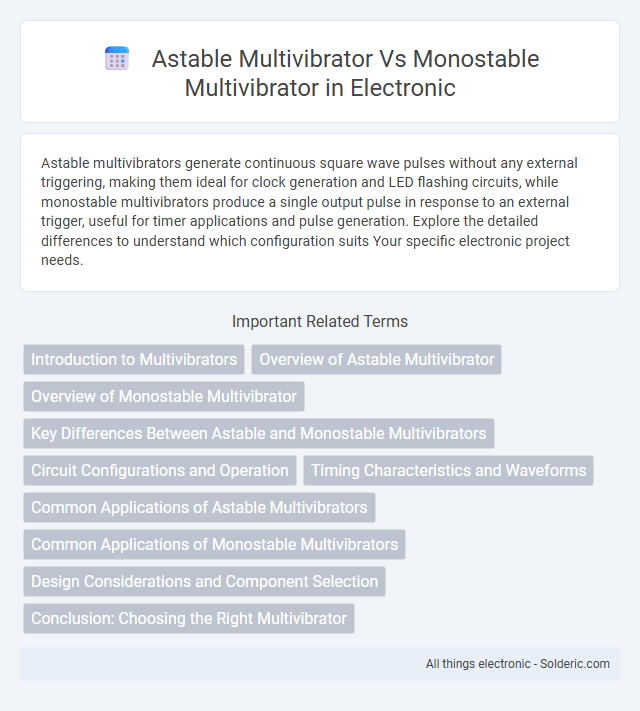Astable multivibrators generate continuous square wave pulses without any external triggering, making them ideal for clock generation and LED flashing circuits, while monostable multivibrators produce a single output pulse in response to an external trigger, useful for timer applications and pulse generation. Explore the detailed differences to understand which configuration suits Your specific electronic project needs.
Comparison Table
| Feature | Astable Multivibrator | Monostable Multivibrator |
|---|---|---|
| Operation Mode | Free-running oscillator | One-shot pulse generator |
| Output | Continuous square wave | Single pulse per trigger |
| Stability | No stable state, alternating output | One stable state, temporarily switches state |
| Trigger | No external trigger required | Requires external trigger to activate |
| Time Period | Determined by RC components (frequency adjustable) | Pulse width controlled by RC network |
| Applications | Clock pulses, LED flashers, waveform generation | Timers, pulse generation, switch debouncing |
| Typical Components | Transistors, capacitors, resistors | Transistors, capacitors, resistors |
Introduction to Multivibrators
Multivibrators are essential electronic circuits used for generating square waves and timing signals, with two main types: astable and monostable. An astable multivibrator continuously oscillates between its two unstable states, producing a free-running square wave without any external triggering. In contrast, a monostable multivibrator has one stable state and one unstable state, generating a single output pulse of a specific duration when triggered.
Overview of Astable Multivibrator
An Astable Multivibrator continuously oscillates between its two unstable states without requiring any external triggering, generating a square wave output. It is commonly used for clock pulse generation, blinking lights, and waveform generation due to its free-running operation. Your electronic circuits benefit from its simplicity and reliable frequency generation in timing applications.
Overview of Monostable Multivibrator
A monostable multivibrator, also known as a one-shot multivibrator, generates a single output pulse of fixed duration in response to an external trigger input, making it ideal for timing applications and pulse generation. Unlike the astable multivibrator, which continuously oscillates between two states, the monostable remains stable in one state and only temporarily switches to another state during the output pulse. Commonly implemented using components such as transistors or ICs like the 555 timer, monostable multivibrators offer precise control over pulse width and timing intervals.
Key Differences Between Astable and Monostable Multivibrators
Astable multivibrators generate continuous square wave oscillations without a stable state, making them ideal for clock pulses and LED flashers. Monostable multivibrators have one stable state and produce a single output pulse when triggered, useful for timers and pulse generation. Understanding these differences helps you select the right multivibrator for your timing and waveform applications.
Circuit Configurations and Operation
Astable multivibrators consist of two cross-coupled transistors or operational amplifiers that continuously switch states, producing a square wave output without requiring an external trigger, making them free-running oscillators. Monostable multivibrators have one stable state and one quasi-stable state; they require an external trigger to switch to the quasi-stable state for a predetermined time controlled by an RC network before returning to the stable state. The astable configuration relies on the charging and discharging of capacitors between two active devices for oscillation, while the monostable uses a timing capacitor and resistor to define pulse width triggered by an input signal.
Timing Characteristics and Waveforms
Astable multivibrators generate continuous oscillating waveforms with no stable state, producing a square wave where timing characteristics depend on the resistor-capacitor (RC) network that controls the frequency and duty cycle. Monostable multivibrators produce a single output pulse of fixed duration in response to an input trigger, with the pulse width determined by the RC components, resulting in a precise timing interval before returning to a stable state. Understanding these waveform behaviors and timing parameters is crucial for designing circuits requiring either continuous oscillations or controlled pulse generation tailored to your application.
Common Applications of Astable Multivibrators
Astable multivibrators are widely used in generating continuous square wave signals essential for clock pulses, LED flashers, and tone generators in electronic circuits. Your projects benefit from their ability to provide stable oscillations without requiring any external triggering, making them ideal for timing and pulse generation. These circuits are fundamental in applications like pulse-width modulation (PWM) controllers, frequency synthesizers, and basic digital clock circuits.
Common Applications of Monostable Multivibrators
Monostable multivibrators are widely used in timing applications such as pulse generation, delay circuits, and switch debouncing due to their ability to produce a single output pulse of defined duration. They are essential in digital systems for creating precise time delays, waveform shaping, and event triggering. In contrast to astable multivibrators, which operate as continuous oscillators, monostable devices provide a stable output period following an input trigger, making them ideal for one-shot pulse applications.
Design Considerations and Component Selection
Astable multivibrator design focuses on continuous oscillation, requiring precise resistor and capacitor values to set frequency and duty cycle, with components chosen for stability and low tolerance to ensure consistent output. Monostable multivibrator design prioritizes a single pulse generation triggered by an input, where timing components like a capacitor and resistor determine pulse width, making component quality crucial for accurate timing and repeatability. Your choice between these circuits depends on whether you need continuous square wave signals or controlled single pulses, guiding component selection for desired performance.
Conclusion: Choosing the Right Multivibrator
Selecting the appropriate multivibrator depends on the required output waveform and application specificity; an astable multivibrator produces continuous square waves ideal for clock pulses and oscillators, while a monostable multivibrator generates a single pulse triggered by an external event, suited for timing and pulse generation tasks. Considerations include output stability, timing precision, and circuit complexity to optimize performance. Application-driven criteria such as pulse duration control and periodic versus aperiodic signals guide the choice between astable and monostable configurations.
Astable multivibrator vs Monostable multivibrator Infographic

 solderic.com
solderic.com